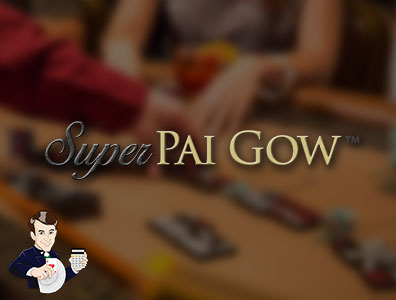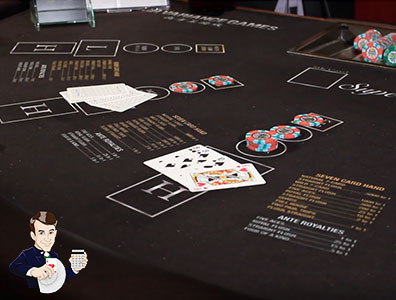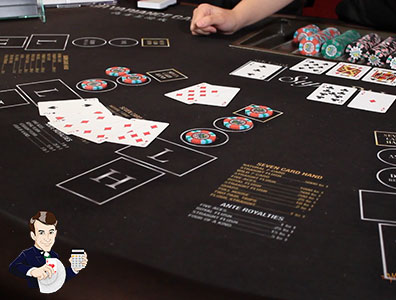Video Review of Super Pai Gow
In this clip, Mike talks with Jeffrey Hwang during the 2018 Cutting Edge Table Games Conference, discussing his innovative game Super Pai Gow. Apologies for the blurry video quality during this segment.
Hello, I’m Mike Shackleford reporting live from the 2018 Cutting Edge Table Game Show held at the Paris Casino in Las Vegas. I have the pleasure of being here with Jeffrey Hwang, who has introduced his game Super Pai Gow.
Jeffrey, can you tell me more about it?
[00:00:36] Jeffrey Hwang: Super Pai Gow is just Pai Gow In this game, players begin with four cards and have the option to raise their bets from one to four times the original ante before drawing three additional cards. The dealer, on the other hand, receives eight cards. An interesting twist is that if a player decides to push, the ante pays out at even odds. In fact, a player can actually win by pushing. In traditional Pai Gow, the chances of winning are 30% and pushing is 40%, leading to a lot of stalemates. However, in Super Pai Gow, the player has nearly a 57% chance of winning hands, effectively making them the favorite.

[00:01:06] Mike: I see there’s a draw bet involved. What happens in the event that a player wins one way but loses in another?
[00:01:14] Jeffrey: The draw bet simply results in a push; it doesn’t affect the outcomes negatively, and the ante actually provides a bonus for the players.
[00:01:19] Mike: So, to clarify, after seeing their first four cards, the player has the option to raise their bet from one to four times their original wager, correct?
[00:01:30] Jeffrey: Yes.
[00:01:31] Mike: If they want to, they can also choose to fold.
[00:01:34] Jeffrey: While a player may fold, it's generally not advisable. There are approximately 23,321 possible starting hands in this game, and it's only correct to fold one specific combination: it's 8732, which occurs roughly once every 12,000 hands. So, in essence, you'll almost never find yourself in a situation where folding is the right choice.
[00:01:48] Mike: After the player makes that choice, they then receive three additional cards?
[00:01:51] Jeffrey: Yes.
[00:01:52] Mike: And then the dealer gets eight cards, turning it into a head-to-head contest similar to Pai Gow?
[00:01:57] Jeffrey: Yes.
[00:01:58] Mike: Would it be alright if we played a few hands to illustrate your points?
[00:02:01] Jeffrey: All right.

[00:02:02] Mike: All right. Thanks Jeffrey.
[00:02:04] Jeffrey: Please place your bets. The dealer will begin by distributing eight cards and giving each player four cards. It's a medium game, allowing for flexibility. You start off with your four cards, and can choose to raise your bet by one to four times. That could very well be a solid hand. Now, let's move on to your final three cards. You will arrange your hand just like in traditional Pai Gow. One important thing to note is that you really only need to push a winning hand, so there’s a strategic reason to curate a stronger one-way hand while keeping two medium-strength hands.
Absolutely, that's quite a strong hand. Good move. Since you decided to push, you’ll win on your ante. Regarding the side wager, it follows the traditional Pai Gow side bet structure. Here, we begin with two pair on the designated pay table, resulting in a win on the side bet with two pair. In essence, the outcome remains the same. Typically, folding isn’t an option; you're better off with strong hands, like two pair against high cards such as aces, with further evaluations based on kickers and suits. A hand like ace 3-5 is considered a 1X hand, which aligns closely with a similar hand.

Now, this hand is quite straightforward with an ace-8. We don’t have a notable four of a kind in this case. The standard house rule here is that whenever two pairs are present, we must split them unless one of the pairs includes an ace. In the current situation, we’ll retain the two pair and use the ace for the low hand. This hand will push, resulting in a win on the ante, and this is a favorable outcome for the house. Now, taking into consideration the ante and optional side bet which utilizes a seven-card hand, starting with two pair is certainly advantageous. We can discuss the maximum raises that allow for three additional cards.
We have quads and Kings …
...so let's not forget the quads—though that was unintentional. The dealer has two pairs, so we will split those. The player wins the scoop, and in addition to that, the ante pays a bonus for achieving quads with the ante providing a five to one bonus and the side wager granting 10-1 for quads.
[00:07:34] Mike: That concludes our overview of Super Pai Gow by Jeffrey Hwang. Thank you for demonstrating the game.
[00:07:40] Jeffrey: All right, thank you.
[00:07:41] Mike: Bye everyone.


